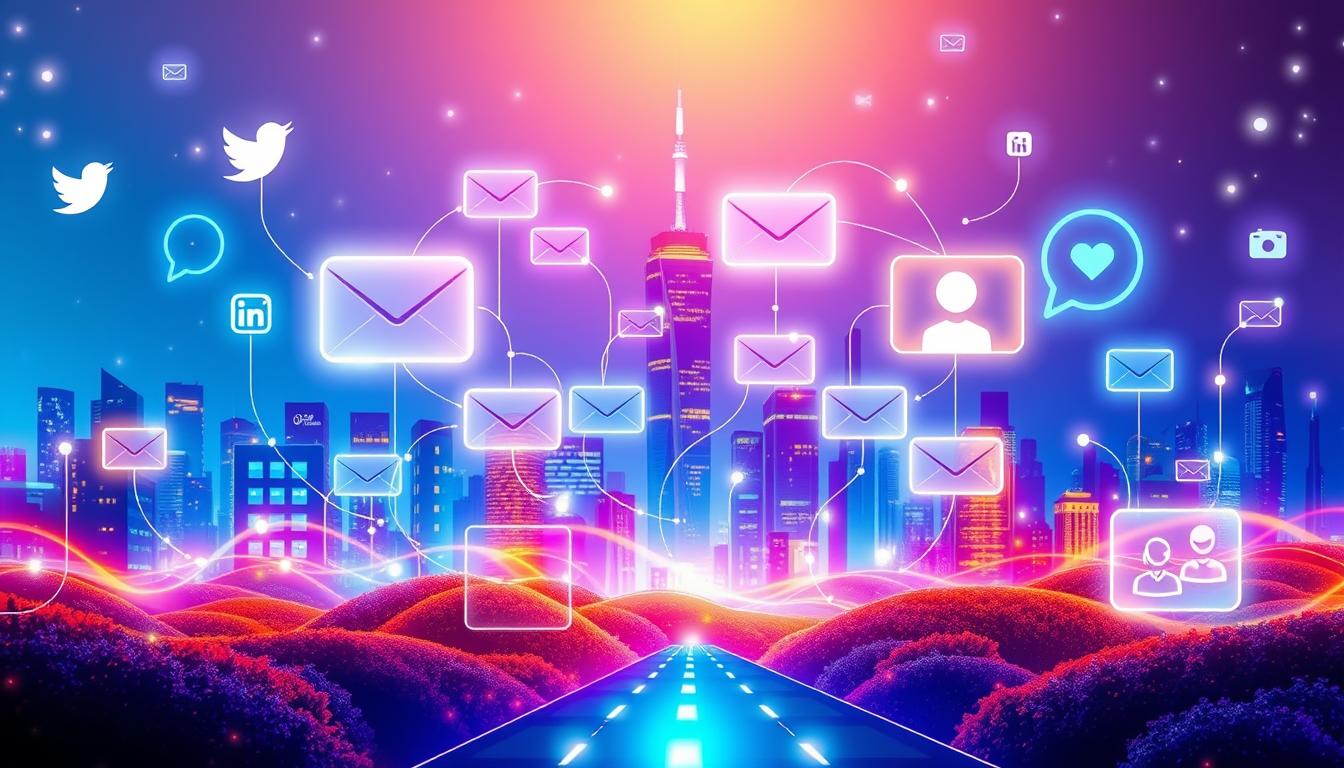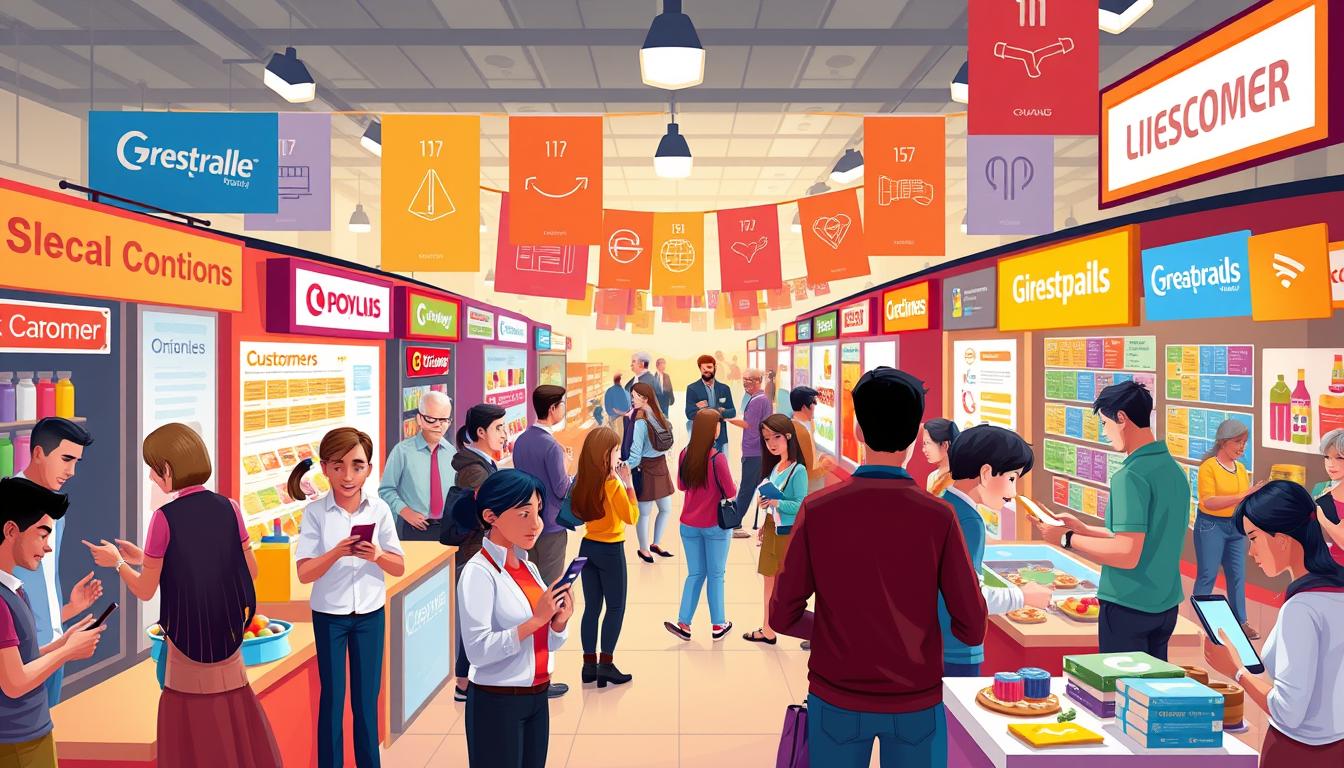As a business owner, you know that talking to your customers is key. Today, we have many ways to communicate, not just phone calls, mail, and face-to-face talks. It’s time to check how well you’re connecting with your customers.
Are you building trust, loyalty, and growth with your customers? It’s important to look at your strategy and find new ways to strengthen your relationships.
The way you talk to your customers matters a lot. You can use email, websites, social media, and video messages. Each method helps you reach your audience better and build strong connections.
So, are you using all these options to their fullest? Or are you missing out on some great opportunities?
In this article, we’ll explore the latest in customer communication. We’ll look at trends, technology, and best practices to help you improve your brand’s engagement. Get ready to learn how to build stronger, more profitable relationships with your customers.
The Evolution of Modern Customer Communication
The way businesses talk to customers has changed a lot lately. With new tech, companies now use a more personal and quick way to reach out. This change has made a big difference in how companies talk to people and how customers feel about it.
Traditional vs Digital Communication Channels
Even though old ways like phone calls and mail are still used, digital methods are now the main way to talk to customers. Tools like email, social media, and chatbots let businesses talk to customers in new ways. These tools make it easier to have conversations that feel more personal and right on time.
Impact of Technology on Business-Customer Relationships
Technology has changed how businesses and customers talk to each other. With personalized messaging, companies can now offer a customer experience that fits what each person likes. This has made the relationship between businesses and customers stronger, building trust and loyalty.
The Multi-Channel Approach Benefits
In today’s world, one way to talk to customers isn’t enough. Businesses that use many ways to communicate are seeing more people interested, happier customers, and more loyalty. By making sure customers can talk to them in their favorite way, companies can keep their customers happy.
“80% of customers now consider the experience a company provides to be as important as its products and services.”

The way businesses talk to customers has really changed. By using digital tools, making messages personal, and talking to customers in many ways, companies can build stronger bonds with their customers. This leads to loyalty and success for the business in the long run.
Essential Digital Platforms for Customer Engagement
In today’s digital world, keeping customers engaged is key for growth. Businesses need to use various platforms to connect well with their audience. Let’s look at the main digital places that help improve your customer retention and communication optimization plans.
Email: A Reliable Communication Channel
Email is a cheap and fast way to send personalized messages, newsletters, and promotions. It helps keep in touch and build relationships. It also boosts sales with targeted campaigns.
Websites: Information Hubs and E-commerce Enablers
Your website is where customers find info, products, and can shop online. A good, easy-to-use website design improves the customer experience and boosts sales.
Social Media: Direct Interactions and Brand Promotion
Social media lets businesses talk directly to their audience. It’s great for sharing content and answering questions. It’s a strong tool for communication optimization and building loyalty.
Mobile Apps: Convenient Access and Personalized Experiences
Mobile apps give customers easy access to your products and services. They offer personalized experiences, helping to keep customers loyal.
Each platform has its own benefits. Combining them into a single strategy is crucial for engaging customers today.
| Digital Platform | Key Benefits | Example Use Cases |
|---|---|---|
|
|
|
| Websites |
|
|
| Social Media |
|
|
| Mobile Apps |
|
|


How Are You Communicating with Your Customers (and Is It Enough)?
In today’s business world, talking to your customers is key. Your communication plan shapes how they see your brand. It also affects their loyalty and interest in what you offer. So, how well do you talk to your customers, and is it enough?
Assessing Your Current Communication Strategy
Start by checking how you talk to your customers now. Look at your channels, how fast you reply, and how happy they are. See if your messages are clear, relevant, and if you’re really talking to them.
Identifying Communication Gaps
After checking your current plan, find out where you’re missing. Do your customers feel like you listen and value them? Are there times when you’re slow to respond or not personal enough? Asking for feedback on social media and surveys can help you see where you need to do better.
Measuring Communication Effectiveness
Good communication isn’t just about talking a lot. It’s about how well you connect and what happens because of it. Set up goals to see if your talking is working. Watch things like how happy customers are, how fast you answer, and how much they interact with you. This helps you know what to fix and make your talking better.
Your customers are crucial to your business. A strong, personal way of talking to them can make them happier and more loyal. It can also help you grow. Look at how you talk to customers now and make sure you’re doing a great job of listening and responding.
| Metric | Importance | Benchmark |
|---|---|---|
| Customer Satisfaction Rate | Measures the overall satisfaction of customers with your communication and service | 90% or higher |
| Response Time | Determines how quickly you’re addressing customer inquiries and concerns | Within 24 hours for email, 1 hour for social media |
| Engagement Level | Indicates the level of customer interaction and interest in your communication | 10-15% average open rate for email, consistent interactions on social media |
“Effective communication with customers can lead to faster problem resolution, reducing the occurrence of recurring issues.”
Building Strong Customer Relationships Through Personalized Messaging
In today’s digital world, customers have many choices. Building lasting relationships is key for businesses. Personalized messaging is a powerful strategy. It makes your communication fit each customer’s needs, improving their experience, loyalty, and retention.
Personalized messaging means using names, referencing past interactions, and suggesting products that fit. It shows you understand and value your customers. Cisco predicts a huge increase in devices connected to IP networks by 2023. This highlights the need for a multi-channel approach to reach customers.
To make personalized messaging work, you need good customer data management and analytics. Use insights from all touchpoints to understand your customers’ journeys. This helps tailor your messages for better interactions.
“Customers who rate an experience 5/5 stars are more than twice as likely to purchase from that company than those who rated it 1 or 2 stars.” – Qualtrics Consumer Trends 2023
Personalized messaging offers many benefits. Loyal customers are more likely to recommend you, saving on new customer costs. Trust built through caring experiences boosts loyalty, reduces churn, and increases customer lifetime value.
To maximize personalized messaging, use different channels like SMS, social media, or online communities. Focus on personalized messaging to build stronger relationships, improve the customer experience, and achieve long-term success.
Mastering the Art of Tone and Language in Customer Communication
The way you write your messages can greatly affect your customer experience. It’s important to have a consistent brand voice across all channels. This helps build a strong, recognizable identity. Using positive language, like focusing on solutions, can improve customer satisfaction and loyalty.
Creating a Consistent Brand Voice
Keeping a consistent brand voice is key to gaining trust and credibility. Your communication should show your company’s values, personality, and commitment to service. A support style guide can help ensure everyone uses the same tone and language, creating a smooth customer experience.
Using Positive Language Techniques
- Emphasize the positive: Frame your messages to highlight benefits and opportunities, not just problems.
- Avoid absolutes: Use flexible language that acknowledges exceptions and nuances instead of absolute terms.
- Showcase empathy: Understand and show you care about the customer’s needs and concerns, aiming to find a solution.
Adapting Communication Style to Different Customers
Customers have different preferences and communication styles based on age, industry, and personal taste. Adapting your style to meet their needs can improve rapport and show you understand them. This personalized approach can strengthen customer relationships and increase loyalty.
| Communication Style | Suitable Customers | Key Considerations |
|---|---|---|
| Formal and Professional | Corporate clients, industry experts | Use precise language, avoid casual expressions, and maintain a polished, authoritative tone. |
| Conversational and Friendly | Younger demographics, small businesses | Adopt a more relaxed, approachable style, use colloquial language, and engage in personalized exchanges. |
| Empathetic and Reassuring | Clients experiencing challenges or concerns | Demonstrate understanding, offer practical solutions, and provide a calming, supportive presence. |
Mastering tone and language in customer communication can build stronger relationships. It enhances your brand reputation and drives greater loyalty and advocacy.
Leveraging Social Media for Customer Engagement
Social media is key for businesses to connect with customers today. With over 5.2 billion active users worldwide, it’s a great way to share your brand’s voice. It helps build loyalty and foster meaningful interactions.
Good social media strategies are about more than just posting. It’s about starting a conversation with your audience. Share interesting content and answer customer questions quickly. This builds a strong community around your brand.
Choosing the right social media platforms is important. Each platform, like Instagram, LinkedIn, or Twitter, has its own benefits. They help you connect with your customers in different ways.
Keeping your brand voice consistent across all platforms is crucial. It makes your brand identity clear and memorable. Your customers get a consistent experience, no matter where they find you online.
“Social media is not just about broadcasting – it’s about building relationships, listening to your customers, and creating a genuine connection with your audience.”
Social media opens up many opportunities for social media engagement and multi-channel engagement. It can drive traffic to your website, boost sales, and build loyalty. Strategic use of social media can change the game for your business.
Strategies for Effective Social Media Engagement
- Create and share visually-appealing, shareable content that resonates with your target audience
- Engage with your customers by promptly responding to comments, messages, and reviews
- Leverage user-generated content (UGC) to build authenticity and foster a sense of community
- Collaborate with relevant influencers to tap into new audiences and add credibility to your brand
- Run contests, giveaways, and interactive campaigns to boost engagement and expand your reach
- Utilize social listening tools to understand audience sentiment and refine your content strategy
| Social Media Platform | Key Engagement Opportunities |
|---|---|
| Visual content, Instagram Stories, live streaming, user-generated content | |
| Real-time engagement, trending topics, curated content, live events | |
| Professional networking, thought leadership, industry-specific content, employee advocacy | |
| Community building, interactive content, live streaming, targeted advertising |
By using these strategies, you can connect deeper with your customers. You can also make your brand more visible and drive results for your business.
Implementing Effective Email Communication Strategies
Email is still a key tool for talking to customers in today’s world. Using email marketing can really help your business grow. It’s all about making your emails count, from newsletters to automated messages.
Newsletter Best Practices
Making great newsletters is an art. To make your emails pop, focus on a few key things:
- Compelling subject lines that grab attention
- Content that’s valuable and informative
- Clear calls-to-action that tell customers what to do next
Automated vs. Personal Email Communications
Automation is great for saving time, but don’t forget about personal touches. Automated emails, like order confirmations, are efficient. But, personal messages, like custom product suggestions, keep things human.
Measuring Email Campaign Success
It’s important to track how well your emails do. Look at open rates, click-through rates, and conversion rates. This helps you see what works and what doesn’t, so you can make your emails better.
Using these email strategies can really boost your business. Email is powerful, but it’s up to you to make it work for your business.
Real-Time Communication Tools and Technologies
In today’s fast-paced business world, real-time communication tools are key for good customer communication. Tools like live chat and video conferencing help with quick customer support. They make interactions personal, improve response times, and boost customer happiness.
Chatbots are a big help in real-time communication. They answer simple questions 24/7, so human agents can focus on harder issues. This mix of automated and human help makes for a great customer experience.
| Tool | Rating | Pricing |
|---|---|---|
| Tidio | 4.7/5 ⭐️ | $29/month |
| Intercom | 4.5/5 ⭐️ | $39/month/seat to $139/month/seat |
| Zendesk | 4.3/5 ⭐️ | $19/month/agent |
| Qualaroo | 4.3/5 ⭐️ | $39.99/month |
| Salesforce | 4.3/5 ⭐️ | $25/month/user |
There are many real-time communication tools to choose from for better customer communication. You can use video calls, instant messages, knowledge bases, and call centers. Pick the right tools for your business to make communication smoother, engage more customers, and build stronger relationships.
“Effective customer communication is the foundation of any successful business. By leveraging the power of real-time communication tools, you can unlock new levels of customer satisfaction and loyalty.”
Customer Feedback and Response Management
In today’s digital world, managing customer feedback is crucial for strong business relationships. From surveys and online reviews to social media, there’s a lot of data to use. This data helps businesses improve how they talk to their audience.
By listening to and acting on customer feedback, you can make big improvements. You can fix problems, find new chances, or just show customers you care. A good system for handling feedback can really help your business grow.
To do well in customer feedback, set up feedback loops and use advanced analytics. Personalized responses are also key. This approach not only improves how you communicate but also shows your brand cares about its customers.
FAQ
How can I expand my customer communication beyond traditional channels?
Today, businesses can use many digital platforms to talk to customers. This includes email, websites, social media, and mobile apps. Using these tools can help you connect with customers better and build stronger bonds.
How has technology transformed business-customer interactions?
Technology has changed how businesses talk to customers. Now, interactions are more personal, quick, and varied. This shift lets businesses meet different customer needs and improve the overall experience through a multi-channel approach.
What are the key digital platforms for customer engagement?
Key platforms for engaging with customers are email, websites, social media, and mobile apps. Each has its own benefits and should be part of a unified communication plan.
How can I evaluate the effectiveness of my current communication strategy?
To check if your strategy works, look at how customers interact with you across all channels. Find out where you might be missing the mark. Look at response times, customer happiness, and how engaged they are. Surveys and feedback are great for getting better.
How can I personalize my communication to build stronger customer relationships?
To make your messages more personal, use names, refer to past talks, and suggest products that fit their needs. This makes customers feel valued, loyal, and more engaged. You’ll need good data management and analytics for this.
How can I develop a consistent brand voice across all communication channels?
Keep your tone and language the same everywhere. Use positive words and adjust your style for different groups. A style guide can help keep your brand voice consistent across your team.
How can I effectively leverage social media for customer engagement?
Good social media strategies include posting often, answering questions quickly, and making content people want to share. Pick platforms that fit your audience and keep your brand voice consistent.
What are the best practices for email communication?
For email newsletters, use catchy subject lines, share valuable content, and make it clear what you want them to do. Mix automated emails with personal ones for efficiency and a human touch. Always check how well your emails are doing to get better.
How can real-time communication tools improve customer experience?
Tools like live chat and video calls can make responses faster and customers happier. Chatbots can answer simple questions 24/7, freeing up people for harder issues.
How can I effectively manage customer feedback?
Listen to, understand, and act on customer feedback, like through surveys and social media. This can turn negatives into positives. A clear plan for managing feedback ensures you use customer insights to improve.
